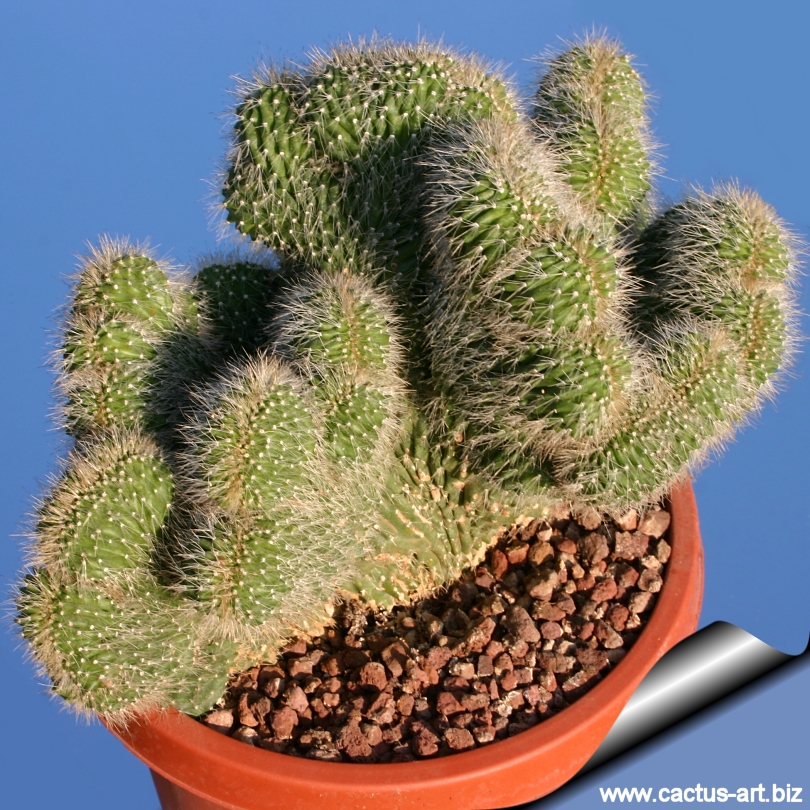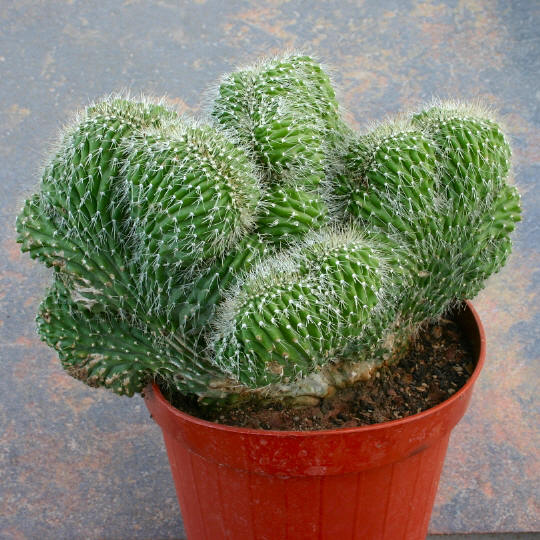|
|
|

Neobuxbaumia
polylopha forma cristata
A large well grown plant is
truly an achievement.
|
|
Description: Neobuxbaumia polylopha is a very
tall columnar cactus with a thick telephone pole-like stem , 7-12(-15) m
tall; Often remain solitary but it can ramify forming a candelabra-like
tree with little curved branches. This plant is characterized by the
many, narrow, closely spaced ribs
Stem: Thick, columnar, deeply ribbed, green.
Ribs: 10-30 narrow, acute
Areoles: Small , 4-6 mm apart with yellowish felt
Spines: Yellowish turning grey as they age, thin, acicular,
bristle-like, mostly pointing downward, approx 1 to 2 cm long.
As ages, spines tend to fall
out.
Central spines: 1
Radial spines: 4 - 8
Flowers: Diurnal, externally green with vivid pink, dark red or
magenta (or orage-yellow) petals near the top of the cactus, their ovary
is sometimes tuberculate, with small scales and red filaments.
Fruits: Small, cylindrical, greenish approx 4 cm long. They
mature rapidly and the seeds can be ready to germinate in only 3 weeks.
They open in a quite peculiar way and form something like a star on the
stem of the plant with the black seeds in contrast with the off-white
colour of the pulp. The fruits are totally exposed to the birds that
devour them quickly. They are also edible for humans, tastes smoothly
sweet and remembers a very mature plum.
The
cause of cresting: The cause of cresting is not fully explained; biologists
disagree as to why some plant grow in this unusual form. Some
speculate that it is a genetic mutation. Others say it is the result of
lightning strike or freeze damage, but whatever the stimulus, the
growth point of the stem has switched from a geometric point, to a line,
which folds and undulates as the crest expands. Though these crested
Neobuxbaumia are somewhat rare (1 in 250,000), cresting occurs naturally, and can be encountered in many
other cactus species.
In the
ontogenesis
a crest can appear any time, but development of crests on large
columnar
cactus species ( such as the saguaro Neobuxbaumia polylopha) in the
early
stages
of ontogenesis is unlikely. On the other hand, small species may crest
early already at the
cotyledons
stage.
|
|
Propagation: Usually
propagated by grafting or from cuttings in spring (let them dry till the
ends callous well). Then replant them in fresh cactus soil that is ever
so slightly moist, and keep it that way till they root)
|
|


Advertising
|
|
|
|
|
Family:
Cactaceae (Cactus
Family)
Scientific name: Neobuxbaumia polylopha (DC)
Backeberg
Place of publication: Blätt. Kakteenf. 1938(6): [24].
1938
forma cristata
Origin: Mexico (endemic to a small area in the state of
Guanajuato, Hidalgo, Querétaro, San Luis Potosí)
Habitat: The Neobuxbaumia polylophas grow
in limestone canyon wall, where they emerge majestically from the thorny
forest, in this area there are several columnar species.
Conservation status: Listed in
CITES appendix 2.
Common Names include: (English) Golden Saguaro,
Golden-spined saguaro, Wax cactus, Cone cactus, (Mexican) Cardón.
Etymology: The species name "polylopha"
means "many ribs"
Synonyms:
- Cereus polylophus DC. (Basyonym)
Place of publication:
Mém. Mus. Hist. Paris, 17 : 115, 1828
- Pilosocereus polylophus (DC.)
Salm Dyck
Place of publication:
Cact. Hort. Dyck. 1844 : 24, 1845
- Cephalocereus polylophus (DC.)
Br. et R.
Place of publication:
Contr. U.S. Nat. Herb., 12 : 419, 1909
- Carnegia polylopha (A.P.de
Candolle) D.R.Hunt 1988
|
|
|
|

Culture: Neobuxbaumia are of easy culture and
can grow 15-20 cm a year. They
are cold intolerant. Make sure they are not
exposed to freezing temperatures ( Hardy to -2°C) or they may die. They
need
a well drained soil mix. It appreciates abundant water during the
summer and, during its growing period but allow to
dry fully before watering again, it is possible to add a
fertilizer 6-6-18 from time to time. During the
winter months they should be rather kept dry. Since they are rapid
growers, they need plenty of space for their roots. Repotting should be
done every other year, or when the plant has outgrown its pot. Sun
Exposure: Light shade when young, full sun later. In mild climate they
can be grown in rock gardens in full sun, in dry and sandy
soils.
|
|
Photo of conspecific taxa, varieties, forms and
cultivars of Neobuxbaumia polylopha.
|
|